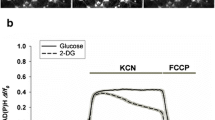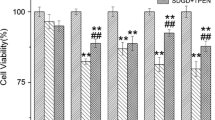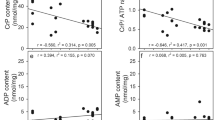Abstract
The effect of inhibited bioenergetics and ATP depletion on membrane composition and fluidity was examined in cultured neuroblastoma-glioma hybrid NG108-15 cells. Sodium cyanide (CN) and 2-deoxyglucose (2-DG) were used to block oxidative phosphorylation and anaerobic glycolysis, respectively. Endoplasmic reticulum (ER) Ca2+-pump activity measured by45Ca2+ uptake was >92% inhibited in intact cells incubated with CN (1 mM) and 2-DG (20 mM) for 30 min. In addition, exposure of cells to CN and 2-DG caused a 134% increased release of isotopically labeled arachidonic acid (3H-AA) or arachidonate-derived metabolites from membranes. Removal of Ca2+ from the incubation medium ablated the CN/2-DG induced release of3H-AA or its metabolites. Membrane fluidity of intact cells was measured by electron spin resonance spectroscopy using the spin label 12-doxyl stearic acid. The mean rotational correlation time (τc) of the spin label increased 49% in CN/2-DG exposed cells compared to controls, indicating a decrease in membrane fluidity. These results show that depletion of cellular ATP results in inhibition of the ER Ca2+-pump, loss of AA from membranes, and decreased membrane fluidity. We propose that impaired bioenergetics can increase intracellular Ca2+ as a result of Ca2+-pump inhibition and thereby activate Ca2+-dependent phospholipases causing membrane effects. Since neurons derive energy predominantly from oxidative metabolism, ATP depletion during brain hypoxia may initiate a similar cytotoxic mechanism.
Similar content being viewed by others
References
Singer, S. J., and Nicolson, G. L. 1972. The fluid mosaic model of the structure of cell membranes. Science 175:720–730.
Seelig, J., and Hasselbach, W. 1971. A spin label study of sarcoplasmic vesicles. Eur. J. Biochem. 21:17–21.
Farias, R. N., Bloj, B., Morero, R. D., Sineriz, F., and Trucco, R. 1975. Regulation of allosteric membrane-bound enzymes through changes in membrane lipid composition. Biochim. Biophys. Acta. 415:231–251.
Domenech, C. E., Machado De Domenech, E. E., Balegno, H. F. De Mendoza, D., and Farias, R. N. 1977. Pesticide action and membrane fluidity. FEBS Lett. 74:243–246.
Saum, W. R., McGee, R., and Love, J. 1981. Alteration of the action potential of tissue cultured neuronal cells by growth in the presence of a polyunsaturated fatty acid. Cell. Mol. Neurobiol. 1:319–323.
Strichartz, G. 1976. Molecular mechanism of nerve block by local anesthetics. Anesthesiology 45:421–441.
Roth, S. H. 1979. Physical mechanisms of anesthesia. Ann. Rev. Pharmacol. Toxicol. 19:159–178.
Nicotera, P., Bellomo, G., and Orrenius, S. 1990. The role of calcium in cell killing. Chem. Res. Toxicol. 3:484–494.
Becker, G. L., Fiskum, G., and Lehninger, A. L. 1980. Regulation of free Ca2+ by liver mitochondria and endoplasmic reticulum. J. Biol. Chem. 255:9009–9012.
Hamprecht, B. 1977 Structural, electrophysiological, biochemical, and pharmacological properties of neuroblastomaglioma cell hybrids in cell culture. Int. Rev. Cytol. 49:99–170.
Ray, P., Middleton, W., and Berman, J. D. 1989. Mechanism of agonist-induced down-regulation and subsequent recovery of muscarinic acetylcholine receptors in a clonal neuroblastoma x glioma hybrid cell line. Neurochem. Res. 52:402–409.
Rogers, E. R., Santos, R. M., Stutzin, A., and Pollard, H. B. 1986. pp. 163–178,in R. Latorre (ed) Ionic Channels in cell and model systems, Plenum Publishing Corp., New york.
Moore, L., Chen, T., Knapp, H. R., Jr., and Landon, E. J. 1975. Energy-dependent calcium sequestration activity in rat liver microsomes. J. Biol. Chem. 250:4562–4568.
Lowry, O. H., Rosebrough, N. J., Farr, A. L., and Randall, R. J. 1951. Protein measurement with the folin-phenol reagent. J. Biol. Chem. 193:265–275.
Tsien, R. Y., Pozzan, T., and Rink, T. J. 1982. Calcium homeostasis in intact lymphocytes: cytoplasmic free calcium monitored with a new intracellular trapped fluorescent indicator. J. Cell. Biol. 94:325–333.
Mayfield, J. E. D., and Leslie, S. W. 1991. Mechanism of inhibition of N-methyl-D-aspartate-stimulated increases in free intracellular Ca2+ concentration by ethanol. J. Neurochem. 56:1536–1543.
Kanterman, R. Y., Felder, C. C., Brenneman, D. M., Ma, A. L., Fitzgerald, S. and Axelrod, J. 1990. Adrenergic receptor mediates arachidonic acid release in spinal cord neurons independent of inositol phospholipid turnover. J. Neurochem. 54:1225–1232.
Fink, D. W., Jr., and Guroff, G. 1990. Nerve growth factor stimulation of arachidonic acid release from PC12 cells. J. Neurochem. 55:1716–1726.
Keith, A., Bulfield, G. and Snipes, W. 1970. Spin-labeled neurospora mitochondria. Biophys. J. 10:618–629.
Kurzinger, K, Stadtkus, C., and Hamprecht, B. 1980. Uptake and energy-dependent extrusion of calcium in neural cells in culture. Eur. J. Biochem. 103:597–611.
Johnson, J. D., Conroy, W. G. and Isom, G. E. 1987. Alteration of cytosolic calcium levels in PC12 cells by potassium cyanide. Toxicol. and Appl. Pharmacol. 88:217–224.
Shinitzky, M. 1984. Biomembranes: Membrane Fluidity pages 585–601,in Kates, M. and Manson, L.A., (eds) Vol 12 Plenum Press, New York.
Freyss-Beguin, M., Millanvoye-Van Brussel, E., and Duval, D. 1989. Effect of oxygen deprivation on metabolism of arachidonic acid by cultures of rat heart cells. Amer. J. Physiol. 257:H444-H451.
Eletr, S., and Keith, A. D. 1972. Spin-label studies of dynamics of lipid alkyl chains in biological membranes: role of unsaturated sites. Proc. Natl. Acad. Sci. U.S.A. 69:1353–1357.
Hubbell, W. L. and McConnell, H. N. 1969. Orientation and motion of amphiphilic spin labels in membranes. Proc. Natl. Acad. Sci. US. 64:20–27.
Lenaz, G., Curtola, G., Mazzanti, L., and Parenti-Castelli, G. 1978. Biophysical studies on agents affecting the state of membrane lipids: biochemical and pharmacological implications. Mol. Cell. Biochem. 22:3–31.
Author information
Authors and Affiliations
Rights and permissions
About this article
Cite this article
Ray, P., Ray, R., Broomfield, C.A. et al. Inhibition of bioenergetics alters intracellular calcium, membrane composition, and fluidity in a neuronal cell line. Neurochem Res 19, 57–63 (1994). https://doi.org/10.1007/BF00966729
Accepted:
Issue Date:
DOI: https://doi.org/10.1007/BF00966729




